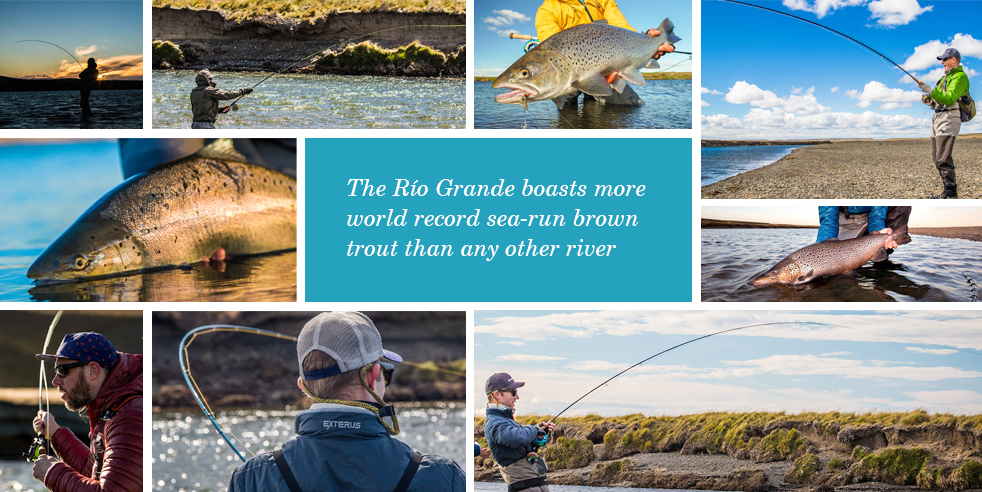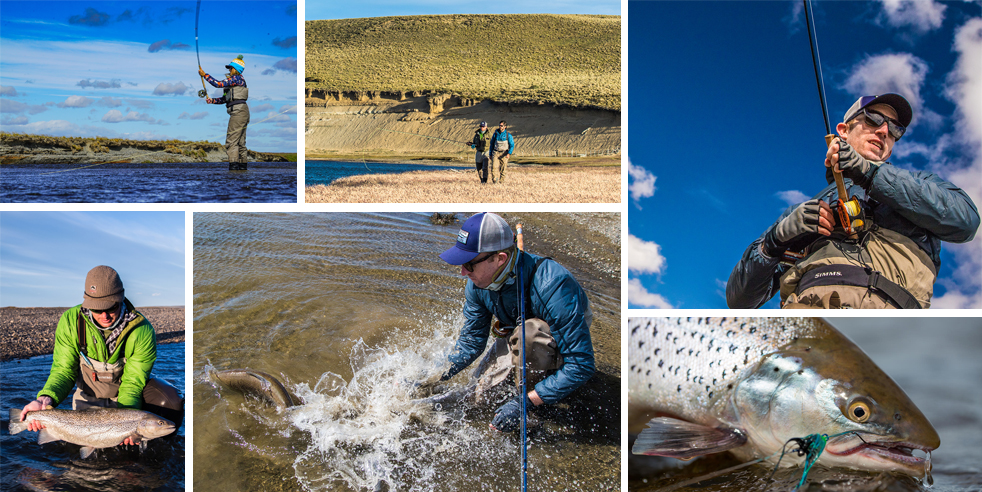Sea-run browns are beloved by intrepid fly anglers everywhere, and of all the places we travel to target these formidable fish, Tierra del Fuego stands out as remarkable due to the size and power of its record-breaking fish.
Fishing the Rio Grande
In 1935, Englishman John Goodall planted the first brown trout in Tierra del Fuego. Imported from Puerto Montt, Chile, 60,000 Salmo trutta eggs were dropped in two tributaries of the Rio Grande. These industrious trout have since found their way to the sea, where they grow large and robust before returning to the Rio Grande to propagate the next generations.
Sea-run browns spawn during fall in the Southern Hemisphere (late March, April, and May). Juveniles typically spend one to four years in freshwater before their first migration to the sea. In the ocean, they feed and grow for approximately six months before returning to the river—weighing about three to six pounds. Trout, unlike salmon, will spawn and return to the ocean multiple times through the course of a lifetime. Researchers have reported sea-run specimens that have bred more than a half-dozen times. Returning trout that have completed four spawning cycles weigh more than 20 pounds. Catch-and-release practices have benefitted return numbers and overall population health in recent years.
Fly Fishing for Sea-Run Brown Trout
Sea-run browns are beloved by intrepid fly anglers everywhere, and of all the places we travel to target these formidable fish, Tierra del Fuego stands out as remarkable due to the size and power of its record-breaking fish.
Sea-run brown trout (salmo trutta) were introduced to the rivers of Tierra del Fuego by British expat John Goodall in the 1930s. Long story distilled, those industrious imports eventually discovered the Atlantic, attracted by its abundant food supply. They packed on the pounds during their oceanic sabbaticals, and upon re-entering freshwater to propagate the next generation, they had reached otherworldly proportions. Fly fishers have rejoiced ever since.
Fisherman tend to describe Tierra del Fuego as the end of the earth, which is an apt characterization considering it is at the end of the earth. The island archipelago marks the southernmost extreme of the Americas; where human development has come at a glacial pace, mostly thanks to its utter remoteness. Area rivers were formed in the Andes, where they are propelled by mountain gradient toward the flat rolling steppes, finally fanning out into the brackish estuaries of the South Atlantic. The Río Grande, the largest watershed on Tierra del Fuego’s Isla Grande, you’ll today find the largest population of sea-run browns anywhere on the planet—an annual return of tens of thousands of wild trout.
Similar to steelhead in the northern hemisphere, the anadromous browns of Tierra del Fuego enjoy a cult-like following – and for a good reason. Savvy anglers build their fishing schedules around run timings to hit the migration during its peak. By January, chrome fish push into the river and through mid-March fly fishers are targeting—and catching—sea-run brown trout that average in the teens, but break the 20+ pound mark regularly. The Río Grande boasts more world record sea-run brown trout than any other river, and pioneering lodges such as Kau Tapen and Villa Maria have been quietly witnessing those special events for decades.
Kau Tapen is a sea-run brown trout institution that’s steeped in regional history. Located in the middle section of the Río Grande, and adjacent to the river’s best tributary, the Río Menendez, the lodge has been serving spectacular sea-run brown trout fishing since the early 1980s. In addition to exclusive access to unpressured beats, the atmosphere inside Villa Maria is unmatched. The great hall features a grand fireplace where anglers can kick back, sip Malbec, and add their stories to the aura. Fine dining is a breakfast, lunch, and dinner standard, and immaculately appointed rooms provide a cozy sanctuary for hardworking anglers at day’s end.
Anglers at Villa Maria, on the other hand, have the benefit of fishing the lower portions of the Río Grande, where its braided waters are home to some of the freshest, fiercest sea-run brown trout in the system. This section is ideal for spey casters due to its longer and broader pools that cater beautifully to the swing.
At Villa Maria, you will experience the same quilty of service you expect and receive at Kau Tapen. Everything from the highly experienced seasoned fishing guides to the veteran waiters and kitchen staff. It will make for a memorable experience both on the water and off the water. One you will never forget. Tierra del Fuego may well be the end of the earth. It’s also a pilgrimage of holy land significance when it comes to brown trout fishing. The pull of Tierra del Fuego is equaled only by the draw of its legendary fishery. On the Río Grande, you will find out why. It may change your life forever.

The Daily Program
Guests will leave the lodge around 9 o’clock after breakfast, fishing till around 1 o’clock. Following lunch and a siesta (the duration depends on the season), guests return to the river in the late afternoon and fish until dark. Fishing hours will change slightly depending on the time of year.
Fishing Techniques
The Rio Grande isn’t a massive river, but it does allow for a wide range of techniques. Water levels can change from week to week, and it generally drops as the season progresses.
Generally speaking, Rio Grande sea-run browns favor cutbanks during midday. In low water, they seek faster riffles. Like steelhead and other migratory fish, they move upstream primarily during the early morning, evening, and nighttime hours. Look for fish distributed throughout pools on calm, overcast days. Begin each drift or swing as close to a cut bank as possible whether the presentation is upstream-and-across, straight-across, or downstream-and-across. Vary your presentations from pool to pool until you find the right formula of fly, line, drift or swing, and retrieve. Always heed the advice of your guide—they are the experts in the nuances of the Rio Grande!
Anglers at Villa Maria, on the other hand, have the benefit of fishing the lower portions of the Río Grande, where its braided waters are home to some of the freshest, fiercest sea-run brown trout in the system. This section is ideal for spey casters due to its longer and broader pools that cater beautifully to the swing.




